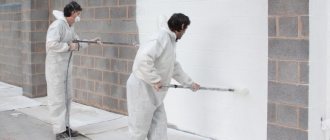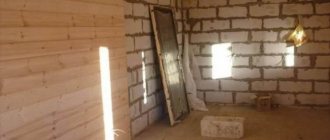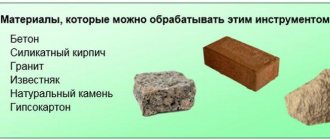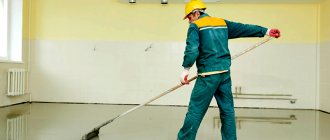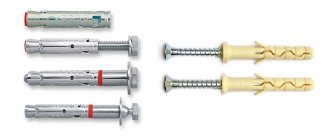Beton-House.com
Website about concrete: construction, characteristics, design. We combine the experience of professionals and private craftsmen in one place
Facade paints will help make the appearance of the building much more attractive.
Most modern buildings are built from concrete. This type of material makes it possible to obtain a very durable structure, which, unfortunately, will have a rather boring gray appearance.
In such a situation, facade paint for concrete will help correct the situation. At the same time, painting the surface will not only change the appearance of the building for the better, but will also improve the performance characteristics of the external walls.
In the article we will look at which façade paints for concrete are preferable to use in this or that case, what requirements paint and varnish materials (paints and varnishes) used on the outside of buildings must meet, and we will also share some secrets of façade work.
- Some nuances of coloring
Painting concrete surfaces - what are the features?
Untreated concrete base is hardened cement, porous and coarse-grained. This texture quickly begins to crumble and become dusty even with minimal impact; when moisture gets in, the concrete breaks down even faster. Water washes out some components of the composition, and at low temperatures freezes in the pores, reducing the strength of the material.
To eliminate these problems, strengthening substances are introduced into the cement mixture, and then additionally stabilized using painting, which eliminates dust, smoothes out roughness, fills the loose structure and protects from moisture, and forms a resistant film that prevents the material from crumbling.
Concrete walls, ceilings, floors, foundations and sidewalks can be painted.
Note! It’s good if the enamel has good hiding power and one layer is enough to completely change the original color of the concrete.
Types of concrete paints that are suitable for interior and exterior work
Concrete paint is selected based on several criteria. The most important is where the work is carried out - outside or inside the premises. For outdoor work, it is important that the material is resistant to low temperatures and UV rays, moisture resistant, dries quickly and looks aesthetically pleasing.
Indoor paint must be safe for health and not contain highly toxic components. For both indoor and outdoor work, the paint should protect the concrete from moisture.
Basic requirements for paint, regardless of where it is used:
- good adhesion,
- vapor permeability,
- abrasion resistance,
- economical consumption.
Classification by composition and type of surface to be painted
To get the desired result, experts recommend paying great attention to choosing the right paint for concrete. There is a lot of different information on the Internet, but there is a standard gradation of materials according to composition and type of surface to be painted.
You can list the main materials by composition:
- Acrylic. These paints are popular not only for concrete surfaces. They contain special polymers and their derivatives, under the influence of which a dense, elastic, breathable film is obtained. Among the advantages of acrylic paints, it is worth noting wear resistance, economical consumption, low price, good hiding power, ease of application, durability of the coating, high drying speed and the ability to use in moderately damp rooms.
- Among the disadvantages, they note the need for careful preparation of the surface for painting, including preliminary priming.
- It is important not to confuse acrylic and alkyd enamels. Alkyd paints are oil paints. They form a hard film on the surface, whose performance properties are worse than those of acrylic compounds.
- Epoxy. They contain epoxy resin and hardener, which must be mixed with a construction mixer to obtain finished enamel. The result is that a waterproof, durable film hardens on the concrete base, which is resistant to any type of impact and retains its appearance for a long time. Therefore, it is often purchased for painting concrete floors. Depending on additional components, the film can be flexible or rigid.
- Among the disadvantages is the possibility of an error in proportions during preparation of the composition.
- Vinyl. These paints create a beautiful matte surface, dry quickly, cover well in one coat, are odorless, environmentally friendly and hypoallergenic. However, now they have almost been replaced by acrylic analogues, since the service life of vinyl coating is no more than 7 years, it is not moisture resistant enough and almost does not “breathe”, which means that concrete deteriorates faster.
- Polyurethane. This is an ideal paint for concrete floors. Particularly resistant to abrasion and mechanical stress. The only negative is the long drying time; complete drying takes up to two weeks.
- Rubber. The consistency is similar to mastic, which after drying resembles rubber. The coating is very durable, but at the same time elastic due to the acrylate latex in the composition. One of the advantages is frost resistance: you can work with paint outside even at -50 degrees. Latex paints are often used on playgrounds and sports fields.
- Water-based. The main component of paint is water, so such materials are non-toxic, easy to wash off, do not smell and are available in a wide palette of shades.
- Silicone emulsion. One of the best offers in terms of its characteristics on the market. It can be used within two days after the concrete has hardened. The enamel forms a completely waterproof, but at the same time “breathable” coating, has high adhesion, is elastic, and wear-resistant. The only drawback is the very high price.
Depending on the surface that is supposed to be painted, there are:
- Concrete enamel for facade. Concrete walls of buildings must be protected from aggressive environmental influences. What is important here is the high penetrating ability of the composition and economical consumption, as well as service life, since repainting building facades is not a very fast and labor-intensive process.
- Foundation paints. Acrylic, polyurethane, epoxy, and silicone compounds are suitable here. When choosing, you need to be guided by the characteristics of concrete and environmental factors. For example, for cold regions, paints based on epoxy resins are used.
- Floor paints. Paints for concrete floors must meet several criteria - resistance to abrasion and mechanical damage, as well as moisture resistance. Polyurethane, acrylic, rubber, epoxy enamels have these properties.
- Materials for painting paving slabs, concrete garden paths and blind areas. The same requirements apply to these paints as to floor paints. But additional attention is paid to protection from precipitation, so acrylic compounds are not suitable here.
How to choose the right paint
To choose a good paint, it is recommended to pay attention to several points.
First you need to assess the intensity of use of the concrete base. For example, to paint walls you will need less wear-resistant enamel than to paint a concrete floor in a garage.
It is important where the painting will be done. For interior work, non-toxic, odorless enamel is required. For outdoor work, resistance to precipitation, UV rays and external damage is important.
Many manufacturers produce universal paints, and before choosing one, you need to carefully study the composition information on the label and recommendations for use.
There is a complete list of requirements for enamels for concrete, however, there is still not a single brand that could combine them all:
- waterproofing properties;
- resistance to low and high temperatures;
- fire resistance;
- health safety;
- neutral smell;
- resistance to physical and mechanical damage;
- ease of care.
Review of manufacturers
DULUX. The production workshops are run by the joint concern ALKO NOBEL. The association produces high-quality products that are sold in 26 countries around the world. The line includes paints for external facades and interior painting.
COLORIT. The popular brand is manufactured at the Tikkurila in Kiev. The products are presented with latex paints for interiors, decoration, and facade treatment.
JOKER. The second representative of Tikkurila has facilities in St. Petersburg. It produces environmentally friendly products and sells goods in Russia and Scandinavia.
SNIEZKA . The brand has gained popularity due to the high quality of paints of various compositions. Snow-white mixtures are always in demand.
SADOLIN. The line of the famous manufacturer includes paints with different structures and textures. Latex compositions imitate natural stone, natural wood, fabric surfaces, steel, glass, silk.
Which wear-resistant material should I use for a concrete floor to avoid dust?
When deciding what to paint a concrete floor with, craftsmen recommend paying attention to deep penetration paints. The porous structure of concrete is very fragile and when the partitions between the pores break, the surface begins to gather dust. To avoid this, you need to fill the empty pores with paint, which will give strength to the material and increase its wear resistance.
There are two methods of painting concrete - deep and surface.
With deep coloring, the enamel penetrates deep into the porous structure of concrete, giving it a lasting color and improving the strength and durability of the material. This technology is quite expensive, so surface painting is often used.
Epoxy, polyurethane or rubber are commonly used as wear-resistant paints for concrete floors. Polyurethane can be painted in industrial premises due to its high resistance to mechanical damage.
Note! In order for the paint to adhere well, you must first prime the concrete screed. The use of deep penetration primer and paint will ensure optimal durability of the coating.
Consumption per 1m2
| Name | Consumption per 1m2 | Life time |
| Silicate | 0.2 kg | 7 years |
| Oily | 0.2 kg | 5 years |
| Acrylic | 0.4 kg | 10 years |
| Polymer | 0.4 kg | 20 years |
| Vinyl | 0.25kg | 7 years |
| Water-epoxy | 0.250 kg | 8 years |
Note! The data provided is approximate. Consumption depends on the specific material and is indicated on the label.
Preparing concrete walls for painting
The process of preparing concrete walls for painting consists of several stages.
- Surface cleaning, which may include: removal of old oil paint, removal of mold and dirt. If the concrete is fresh, cement laitance forms on its surface, which must be sanded after the material has dried.
- Removing dust from the surface (you can use a vacuum cleaner).
- If there are cracks and potholes, they are filled with plaster, putty or polyurethane foam.
- After the mixture has dried, the surface is sanded manually or with a special grinding machine and then primed.
Now you can proceed to painting, having previously carried out tinting. To do this, use a white base paint and add pigment.
Consumer recommendations
- Many consumers apply paint to plaster. It is noted that the decorative surface usually has a clearly defined relief, so the higher the surface relief, the greater the paint consumption.
- You can begin painting work only after completion of preparation. If the surface of the walls has smooth and convex areas, you need to start painting with those that protrude.
- Painting on a plastered surface has several features. It is necessary to choose the right paint, prepare the walls and correctly apply the mixture to them. This is the only way to achieve the desired result.
